Chenhao Zhang
GraphTEN: Graph Enhanced Texture Encoding Network
Mar 18, 2025Abstract:Texture recognition is a fundamental problem in computer vision and pattern recognition. Recent progress leverages feature aggregation into discriminative descriptions based on convolutional neural networks (CNNs). However, modeling non-local context relations through visual primitives remains challenging due to the variability and randomness of texture primitives in spatial distributions. In this paper, we propose a graph-enhanced texture encoding network (GraphTEN) designed to capture both local and global features of texture primitives. GraphTEN models global associations through fully connected graphs and captures cross-scale dependencies of texture primitives via bipartite graphs. Additionally, we introduce a patch encoding module that utilizes a codebook to achieve an orderless representation of texture by encoding multi-scale patch features into a unified feature space. The proposed GraphTEN achieves superior performance compared to state-of-the-art methods across five publicly available datasets.
CrossView-GS: Cross-view Gaussian Splatting For Large-scale Scene Reconstruction
Jan 03, 2025Abstract:3D Gaussian Splatting (3DGS) has emerged as a prominent method for scene representation and reconstruction, leveraging densely distributed Gaussian primitives to enable real-time rendering of high-resolution images. While existing 3DGS methods perform well in scenes with minor view variation, large view changes in cross-view scenes pose optimization challenges for these methods. To address these issues, we propose a novel cross-view Gaussian Splatting method for large-scale scene reconstruction, based on dual-branch fusion. Our method independently reconstructs models from aerial and ground views as two independent branches to establish the baselines of Gaussian distribution, providing reliable priors for cross-view reconstruction during both initialization and densification. Specifically, a gradient-aware regularization strategy is introduced to mitigate smoothing issues caused by significant view disparities. Additionally, a unique Gaussian supplementation strategy is utilized to incorporate complementary information of dual-branch into the cross-view model. Extensive experiments on benchmark datasets demonstrate that our method achieves superior performance in novel view synthesis compared to state-of-the-art methods.
Toward Efficient Data-Free Unlearning
Dec 18, 2024Abstract:Machine unlearning without access to real data distribution is challenging. The existing method based on data-free distillation achieved unlearning by filtering out synthetic samples containing forgetting information but struggled to distill the retaining-related knowledge efficiently. In this work, we analyze that such a problem is due to over-filtering, which reduces the synthesized retaining-related information. We propose a novel method, Inhibited Synthetic PostFilter (ISPF), to tackle this challenge from two perspectives: First, the Inhibited Synthetic, by reducing the synthesized forgetting information; Second, the PostFilter, by fully utilizing the retaining-related information in synthesized samples. Experimental results demonstrate that the proposed ISPF effectively tackles the challenge and outperforms existing methods.
Bootstrapping Heterogeneous Graph Representation Learning via Large Language Models: A Generalized Approach
Dec 11, 2024



Abstract:Graph representation learning methods are highly effective in handling complex non-Euclidean data by capturing intricate relationships and features within graph structures. However, traditional methods face challenges when dealing with heterogeneous graphs that contain various types of nodes and edges due to the diverse sources and complex nature of the data. Existing Heterogeneous Graph Neural Networks (HGNNs) have shown promising results but require prior knowledge of node and edge types and unified node feature formats, which limits their applicability. Recent advancements in graph representation learning using Large Language Models (LLMs) offer new solutions by integrating LLMs' data processing capabilities, enabling the alignment of various graph representations. Nevertheless, these methods often overlook heterogeneous graph data and require extensive preprocessing. To address these limitations, we propose a novel method that leverages the strengths of both LLM and GNN, allowing for the processing of graph data with any format and type of nodes and edges without the need for type information or special preprocessing. Our method employs LLM to automatically summarize and classify different data formats and types, aligns node features, and uses a specialized GNN for targeted learning, thus obtaining effective graph representations for downstream tasks. Theoretical analysis and experimental validation have demonstrated the effectiveness of our method.
Can MLLMs Understand the Deep Implication Behind Chinese Images?
Oct 17, 2024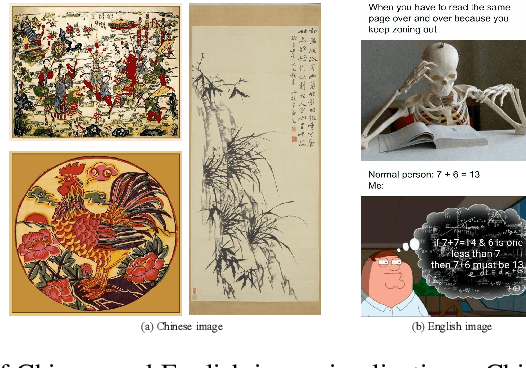
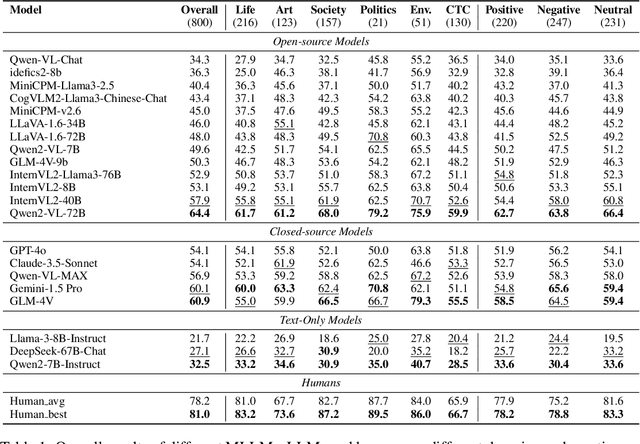
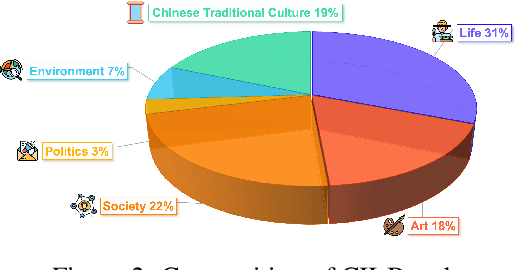
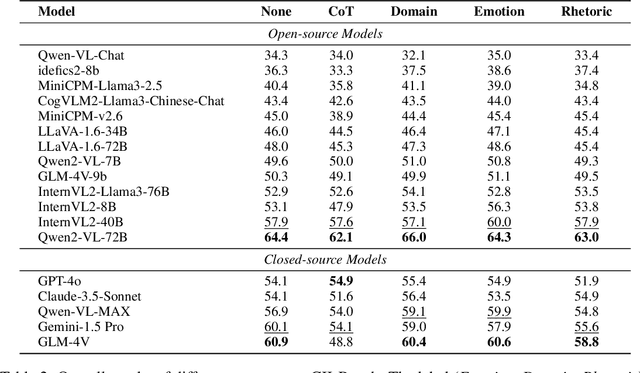
Abstract:As the capabilities of Multimodal Large Language Models (MLLMs) continue to improve, the need for higher-order capability evaluation of MLLMs is increasing. However, there is a lack of work evaluating MLLM for higher-order perception and understanding of Chinese visual content. To fill the gap, we introduce the **C**hinese **I**mage **I**mplication understanding **Bench**mark, **CII-Bench**, which aims to assess the higher-order perception and understanding capabilities of MLLMs for Chinese images. CII-Bench stands out in several ways compared to existing benchmarks. Firstly, to ensure the authenticity of the Chinese context, images in CII-Bench are sourced from the Chinese Internet and manually reviewed, with corresponding answers also manually crafted. Additionally, CII-Bench incorporates images that represent Chinese traditional culture, such as famous Chinese traditional paintings, which can deeply reflect the model's understanding of Chinese traditional culture. Through extensive experiments on CII-Bench across multiple MLLMs, we have made significant findings. Initially, a substantial gap is observed between the performance of MLLMs and humans on CII-Bench. The highest accuracy of MLLMs attains 64.4%, where as human accuracy averages 78.2%, peaking at an impressive 81.0%. Subsequently, MLLMs perform worse on Chinese traditional culture images, suggesting limitations in their ability to understand high-level semantics and lack a deep knowledge base of Chinese traditional culture. Finally, it is observed that most models exhibit enhanced accuracy when image emotion hints are incorporated into the prompts. We believe that CII-Bench will enable MLLMs to gain a better understanding of Chinese semantics and Chinese-specific images, advancing the journey towards expert artificial general intelligence (AGI). Our project is publicly available at https://cii-bench.github.io/.
Chemistry-Inspired Diffusion with Non-Differentiable Guidance
Oct 09, 2024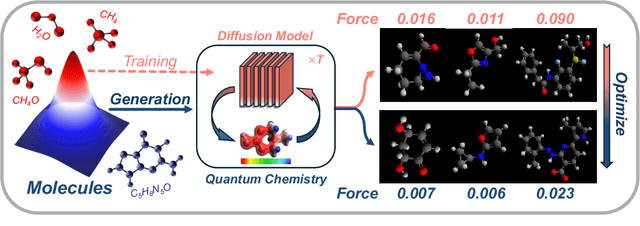



Abstract:Recent advances in diffusion models have shown remarkable potential in the conditional generation of novel molecules. These models can be guided in two ways: (i) explicitly, through additional features representing the condition, or (ii) implicitly, using a property predictor. However, training property predictors or conditional diffusion models requires an abundance of labeled data and is inherently challenging in real-world applications. We propose a novel approach that attenuates the limitations of acquiring large labeled datasets by leveraging domain knowledge from quantum chemistry as a non-differentiable oracle to guide an unconditional diffusion model. Instead of relying on neural networks, the oracle provides accurate guidance in the form of estimated gradients, allowing the diffusion process to sample from a conditional distribution specified by quantum chemistry. We show that this results in more precise conditional generation of novel and stable molecular structures. Our experiments demonstrate that our method: (1) significantly reduces atomic forces, enhancing the validity of generated molecules when used for stability optimization; (2) is compatible with both explicit and implicit guidance in diffusion models, enabling joint optimization of molecular properties and stability; and (3) generalizes effectively to molecular optimization tasks beyond stability optimization.
Standard compliant video coding using low complexity, switchable neural wrappers
Jul 10, 2024Abstract:The proliferation of high resolution videos posts great storage and bandwidth pressure on cloud video services, driving the development of next-generation video codecs. Despite great progress made in neural video coding, existing approaches are still far from economical deployment considering the complexity and rate-distortion performance tradeoff. To clear the roadblocks for neural video coding, in this paper we propose a new framework featuring standard compatibility, high performance, and low decoding complexity. We employ a set of jointly optimized neural pre- and post-processors, wrapping a standard video codec, to encode videos at different resolutions. The rate-distorion optimal downsampling ratio is signaled to the decoder at the per-sequence level for each target rate. We design a low complexity neural post-processor architecture that can handle different upsampling ratios. The change of resolution exploits the spatial redundancy in high-resolution videos, while the neural wrapper further achieves rate-distortion performance improvement through end-to-end optimization with a codec proxy. Our light-weight post-processor architecture has a complexity of 516 MACs / pixel, and achieves 9.3% BD-Rate reduction over VVC on the UVG dataset, and 6.4% on AOM CTC Class A1. Our approach has the potential to further advance the performance of the latest video coding standards using neural processing with minimal added complexity.
Gaussian Splatting with Localized Points Management
Jun 13, 2024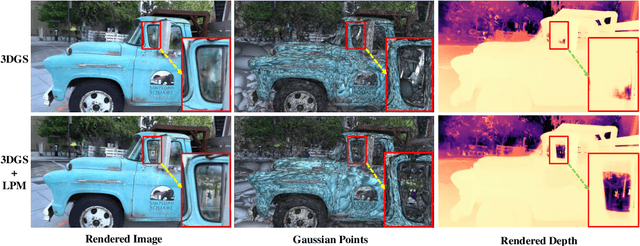

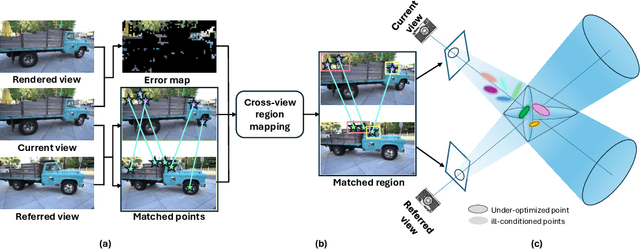

Abstract:Point management is a critical component in optimizing 3D Gaussian Splatting (3DGS) models, as the point initiation (e.g., via structure from motion) is distributionally inappropriate. Typically, the Adaptive Density Control (ADC) algorithm is applied, leveraging view-averaged gradient magnitude thresholding for point densification, opacity thresholding for pruning, and regular all-points opacity reset. However, we reveal that this strategy is limited in tackling intricate/special image regions (e.g., transparent) as it is unable to identify all the 3D zones that require point densification, and lacking an appropriate mechanism to handle the ill-conditioned points with negative impacts (occlusion due to false high opacity). To address these limitations, we propose a Localized Point Management (LPM) strategy, capable of identifying those error-contributing zones in the highest demand for both point addition and geometry calibration. Zone identification is achieved by leveraging the underlying multiview geometry constraints, with the guidance of image rendering errors. We apply point densification in the identified zone, whilst resetting the opacity of those points residing in front of these regions so that a new opportunity is created to correct ill-conditioned points. Serving as a versatile plugin, LPM can be seamlessly integrated into existing 3D Gaussian Splatting models. Experimental evaluation across both static 3D and dynamic 4D scenes validate the efficacy of our LPM strategy in boosting a variety of existing 3DGS models both quantitatively and qualitatively. Notably, LPM improves both vanilla 3DGS and SpaceTimeGS to achieve state-of-the-art rendering quality while retaining real-time speeds, outperforming on challenging datasets such as Tanks & Temples and the Neural 3D Video Dataset.
GENIU: A Restricted Data Access Unlearning for Imbalanced Data
Jun 12, 2024



Abstract:With the increasing emphasis on data privacy, the significance of machine unlearning has grown substantially. Class unlearning, which involves enabling a trained model to forget data belonging to a specific class learned before, is important as classification tasks account for the majority of today's machine learning as a service (MLaaS). Retraining the model on the original data, excluding the data to be forgotten (a.k.a forgetting data), is a common approach to class unlearning. However, the availability of original data during the unlearning phase is not always guaranteed, leading to the exploration of class unlearning with restricted data access. While current unlearning methods with restricted data access usually generate proxy sample via the trained neural network classifier, they typically focus on training and forgetting balanced data. However, the imbalanced original data can cause trouble for these proxies and unlearning, particularly when the forgetting data consists predominantly of the majority class. To address this issue, we propose the GENerative Imbalanced Unlearning (GENIU) framework. GENIU utilizes a Variational Autoencoder (VAE) to concurrently train a proxy generator alongside the original model. These generated proxies accurately represent each class and are leveraged in the unlearning phase, eliminating the reliance on the original training data. To further mitigate the performance degradation resulting from forgetting the majority class, we introduce an in-batch tuning strategy that works with the generated proxies. GENIU is the first practical framework for class unlearning in imbalanced data settings and restricted data access, ensuring the preservation of essential information for future unlearning. Experimental results confirm the superiority of GENIU over existing methods, establishing its effectiveness in empirical scenarios.
II-Bench: An Image Implication Understanding Benchmark for Multimodal Large Language Models
Jun 11, 2024



Abstract:The rapid advancements in the development of multimodal large language models (MLLMs) have consistently led to new breakthroughs on various benchmarks. In response, numerous challenging and comprehensive benchmarks have been proposed to more accurately assess the capabilities of MLLMs. However, there is a dearth of exploration of the higher-order perceptual capabilities of MLLMs. To fill this gap, we propose the Image Implication understanding Benchmark, II-Bench, which aims to evaluate the model's higher-order perception of images. Through extensive experiments on II-Bench across multiple MLLMs, we have made significant findings. Initially, a substantial gap is observed between the performance of MLLMs and humans on II-Bench. The pinnacle accuracy of MLLMs attains 74.8%, whereas human accuracy averages 90%, peaking at an impressive 98%. Subsequently, MLLMs perform worse on abstract and complex images, suggesting limitations in their ability to understand high-level semantics and capture image details. Finally, it is observed that most models exhibit enhanced accuracy when image sentiment polarity hints are incorporated into the prompts. This observation underscores a notable deficiency in their inherent understanding of image sentiment. We believe that II-Bench will inspire the community to develop the next generation of MLLMs, advancing the journey towards expert artificial general intelligence (AGI). II-Bench is publicly available at https://huggingface.co/datasets/m-a-p/II-Bench.
 Add to Chrome
Add to Chrome Add to Firefox
Add to Firefox Add to Edge
Add to Edge